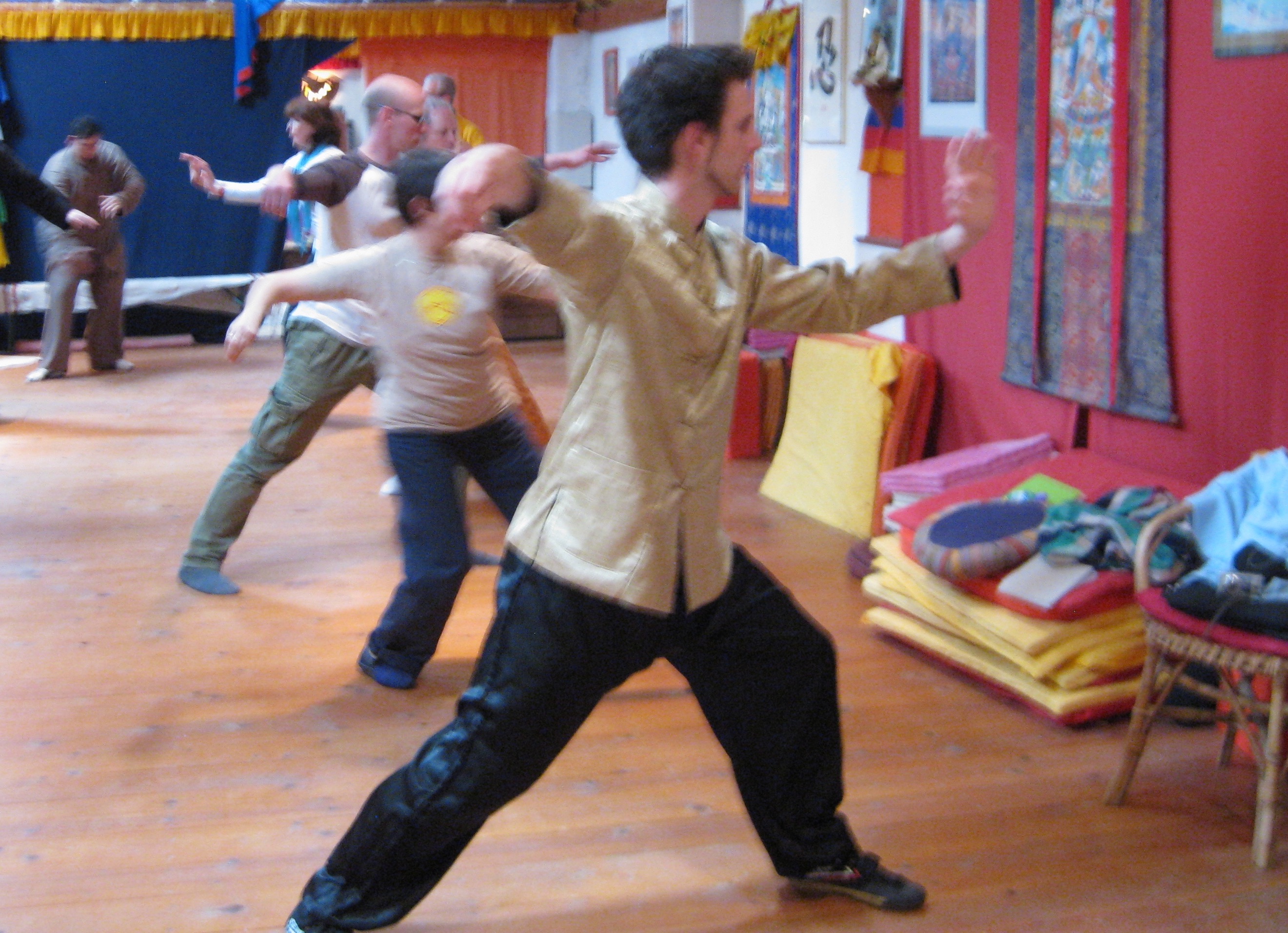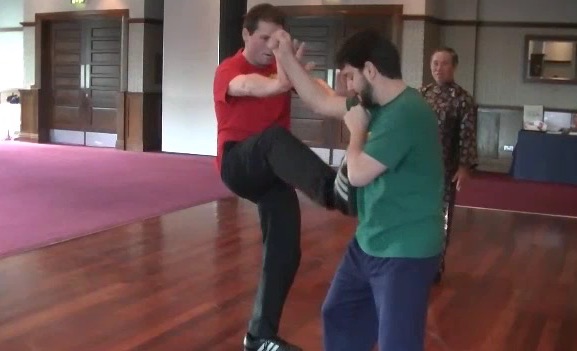WHY IS CLOUD HANDS GRASP SPARROW NOT IN OUR STANDARD SYLLABUS?

Sifu Leonard performing "Single Whip", which is a pattern from Cloud Hands Grasp Sparrow
Question 8
Sifu, why is the Cloud Hands Grasp Sparrow set not included in our standard syllabus?
Sifu Leonard Lackinger
Answer
Although “Cloud Hands Grasp Sparrow” is an excellent set, it is not included in our standard Taijiquan syllabus because the selected set, “White Crane Flaps Wings”, is a better choice for this purpose. For other purposes, like a selective set, “Cloud Hands Grasp Sparrow” is highly recommended.
This leads us to two relevant questions, “Why is “White Crane Flaps Wings” the best choice for our standard Taijiquan syllabus?” and “Why is “Cloud Hands Grasp Sparrow” highly recommended as a selective set?”
If we examine our standard Taijiquan syllabus, which can be accessed at http://www.shaolin.org/review/taijiquan.html, we can see that there is only one foundation set, which is “White Crane Flaps Wings”. The other sets in the syllabus are combat application sets, an advanced set, and weapon sets.
A foundation set is one that lays the foundation that provides the fundamentals of the art and prepares students for future development. A combat application set is one that is composed of combat sequences used in combat application. A weapon set is one that involves a classical weapon.
A selective set is one that students (and instructors) select for some special purposes, like deepening in the art or experiencing the legacies of great masters. Some selective Taijiquan sets are “Cloud Hands Grasp Sparrow” which provides a deeper understanding of Taijiquan, and “108-Yang Style Taijiquan” and “Wudahg Taijiquan” which provide experiencing the legacies of Yang Deng Fu and Zhang San Feng respectively.
Our Taijiquan syllabus is formulated with general aims and specific objectives in mind.
The general aims are to provide students with an understanding and practice of Taijiquan that contribute to their health, vitality, longevity, mental freshness, spiritual joys and combat efficiency.
The specific objectives, which realize the general aims, are to provide students with training in Taijiquan in all the four aspects of form, force, application and philosophy in unarmed as well as selected armed combat, against single as well as multiple opponents.
The four aspects of form, force, application and philosophy are chosen because they give a comprehensive study and practice of the art. For the weapon category, the sword is selected for training because it is Taijiquan is most famous for its sword. The sabre is also selected because, in our opinion, it best represents other weapons. A crescent-moon spear or a three-sectional staff, for example, would not be representative.
Setting aims and objectives will make our training purposeful and cost-effective. We are proud and happy to say that judging from the results of our students, we have achieved our aims and objectives well.
It may seem unnecessary to mention, but I shall still mention it because thousands of thousands of Taijiquan and other martial art practitioners outside our school seem to be unaware of the following fact. If you practice a martial art and become more and more unhealthy, it just contradicts the stated aim that practicing the art makes you healthy. If you practice a martial art and be routinely hit and kicked in free sparring, it just contradicts the stated objective that you learn self-defence.
Before addressing the two relevant questions above, it will be helpful to have a quick look at our Taijiquan syllabus. The form category of the 12 levels of the syllabus is reproduced below.
- Stances. Footwork and Basic Forms
- White Crane Flaps Wings
- White Snake Shoots Venom
- Green Dragon Shoots Pearl
- Black Bear Sinks Hips
- Carry Tiger Back to Mountain
- Wudang Sword
- Taiji Sabre
- Empty Hands Enter White Blade
- Tiger Enters Herd of Sheep
- Dodge Hit
After learning the fundamentals, students learn the basic set of “White Crane Flaps Wings”. The subsequence four levels deal with combat application involving striking, kicking, felling and chin-na. “Flowing Water Floating Clouds” is chosen for advanced study and practice, after which the sword and the sabre are learnt. The next level deals with combat against an armed opponent. The last two levels deal with multiple attacks against unarmed and armed opponents.
“Empty Hands Enter White Blade”, “Tiger Enters Herd of Sheep” and “Dodge Hit” are combat strategies. At present the skills and techniques for these strategies are taught individually. In future, to help students remember them better and practice them coherently, these skills and techniques may be linked into sets.
This was the reason – to enable practitioners to remember the skills and techniques better and practice them coherently – why sets were formed. This was the reason why all the sets in the syllabus, including “White Crane Flaps Wings”, were created.
The same philosophy underlying the Taijiquan syllabus also applies to the Shaolin syllabus, which can be accessed at http://www.shaolin.org/review/shaolin.html.
The form category of the 12 levels of the Shaolin syllabus is reproduced below:
- Basic Patterns, Stances and Footwork.
- Lohan Asks the Way
- Black Tiger Steals Heart
- Fierce Tiger Speeds through Valley
- Happy Bird Hops up Branch
- Felling Tree with Roots
- Cross-Roads at Four Gates
- Flowing Water Staff
- Plum Flower Single Sabre
- Empty Hands Enter White Blade
- Tiger Enters Herd of Sheep
- Dodge Hit
With an understanding of the philosophy behind the Taijiquan syllabus we can now answer with insight why “White Crane Flaps Wings” is the best choice for the foundation set amongst the many Taijiquan sets we have in our school.
At that time we did not have many Taijiquan sets to choose from. We had “Cloud Hands Grasp Sparrow”, which was then called “24-Pattern Simplified Taijiquan”, “108-Yang Style Taijiquan”, “Cloud Hands” and “Flowing Water Floating Clouds”.
The four combat application sets were composed from the 12 basic Taijiquan combat sequences, and thus could not be used as a foundation set. The other Taijiquan sets that we now have – “Yellow Bee Sucks Pollens”, “Old Eager Catches Snake” and “Wudang Taijiquan” – were not created yet. “Yellow Bee Sucks Pollens” and “Old Eager Catches Snake” were later composed from consolidating the 12 basic combat sequences to 8 and 4 combat sequences respectively. “Wudang Taijiquan” was recreated from classical sources.
Of the four Taijiquan sets available then, “Cloud Hands Grasp Sparrow” was the best choice. “Cloud Hands” did not have sufficient techniques to meet the requirement of the Taijiquan syllabus. “108-Yang Style Taijiquan”, was too long, and “Flowing Water Floating Clouds” was too advanced.
Even “Cloud Hands Grasp Sparrow” was lacking in some techniques. For example, there was no low strike, and there was only one type of kicks. Moreover, some patterns, like Repulse Monkey and Golden Cockerel Stands Solitarily, were too advanced.
Hence, I used “Cloud Hands” as a base and added some required techniques to create a new set, to be named “White Crane Flaps Wings” after a beautiful pattern. Initially I thought of naming it “Green Dragon Shoots Pearl”, as this was a prominent pattern in the set. But this name was already taken by the second combat application set.
“White Crane Flaps Wings” was excellent to function as a foundation set. The starting Cloud Hands remind practitioners of how Zhang San Feng developed Taijiquan. The two sequences of Grasping Sparrow’s Tail cover all important Taijiquan movements.
Single Whip provides training for exploding force. The many repetitions of Green Dragon Shoots Pearl provide sufficient training in waist rotation, which is very important in Taijiquan and also which is what many Taijiquan practitioners today are poor at.
The added techniques made “White Crane Flaps Wings” a complete set with all the four categories of attack and defence. The forceful execution of Fierce Dragon Across Stream reminds practitioners that Taijiquan is a martial art.
Sharp observers may notice that “White Crane Flaps Wings” is very rich as a foundation set in Taijiquan compared to “Lohan Asks the Way” in Shaolin Kungfu. A noticeable difference is that “White Crane Flaps Wings” covers all the four categories of striking, kicking, felling and chin-na, whereas “Lohan Asks the Way” covers only one category of striking.
This was due to the improvement of my teaching methodology. When I composed “Lohan Asks the Way” I was just thinking of basic Shaolin patterns. When I composed “White Crane Flaps Wings” I was thinking of not just basic Taijiquan patterns but also that the patterns should include all the four categories of combat.
There was, nevertheless, still a setback in the composition of “White Crane Flaps Wings”. Do you know what it was? There was no side attack. This setback was rectified in “Yellow Bee Sucks Pollens”, “Old Eager Catches Snake”. In fact, the name of the set, “Yellow Bee Sucks Pollens”, highlighted the rectification of this setback.
While “White Crane Flaps Wings” is an excellent foundation set, “Cloud Hands Grasp Sparrow” is an excellent selective set.
Firstly, it is short. It is interesting to note that while most other practitioners think that the longer a set is, it is more advanced, we in Shaolin Wahnam regard a shorter set more advanced than a longer one if both produce the same result. In other words, if you need 56 moves to have the same result as another practitioner who needs 108 moves, you are more advanced.
You are much more advanced if your result is better. This in fact is the case of “Cloud Hands Grasp Sparrow” as a selective set. By performing just 56 patterns of the set, you can develop internal force, apply the patterns for combat besides attaining good health, vitality, longevity, mental freshness and spiritual joys, whereas many other people perform longer sets only for demonstration, and often sustain knee and back injuries.
You will also have these wonderful benefits by practicing the foundation set, “White Crane Flaps Wings”. Why then should you learn “Cloud Hands Grasp Sparrow” as a selective set?
This leads to the third reason. The skills and techniques in “Cloud Hands Grasp Sparrow” are more sophisticated than those in “White Crane Flaps Wings”. Instead of felling an opponent with Carry Tiger Back to Mountain found in “White Crane Flaps Wings”, you can use Repulse Monkey found in “Cloud Hands Grasp Sparrow”, which is less conspicuous but more difficult to defend against.
If an opponent attacks you, irrespective of what attach he uses, you can counter with Dodge Extend Arm, first dodging his attack, and immediately counter-striking him. This pattern, or an application of this principle, is very useful when you press into an opponent relentlessly with your combat sequence.
Fourthly, this set is very effective for practicing the flow method. As the flow method is very important in Taijiquan, this set is invaluable.
Even when a practitioner may not know the flow method, if he performs this set flowingly and gracefully in a relaxed manner, he can eventually generate an energy flow. If he persists regularly in his practice, his energy flow may develop into internal force.
Many other kungfu sets may not have this facility. It is because the arrangement of the patterns in these sets does not encourage flowing and graceful movements, or the performance of some patterns demand physical strength which impedes energy flow.
Why, then, many people who practice the “24-Pattern Simplified Taijiquan Set”, which is the same as “Cloud Hands Grasp Sparrow” except for the added shoulder and elbow strikes, do not have internal force or even energy flow? It is because their performance of the set is not flowing, or not graceful, or not in a relaxed manner, though they think they do.

Dominik applies "Cross-Hand Thrust Kick", a pattern from Cloud Hands Grasp Sparrow, against Ryan
The questions and answers are reproduced from the thread Wahnam Cloud Hands Grasp Sparrow Set: 10 Questions to Grandmaster Wong in the Shaolin Wahnam Discussion Forum.
LINKS
